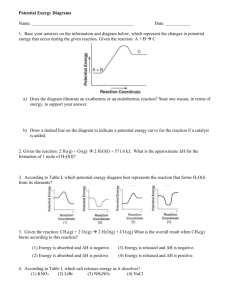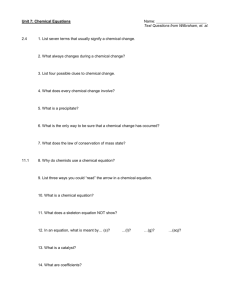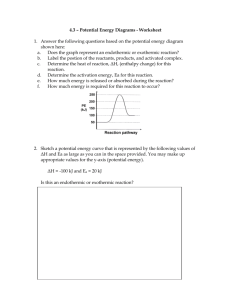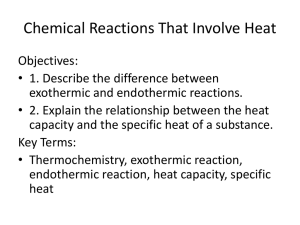CHAPTER 8 REVIEW
advertisement
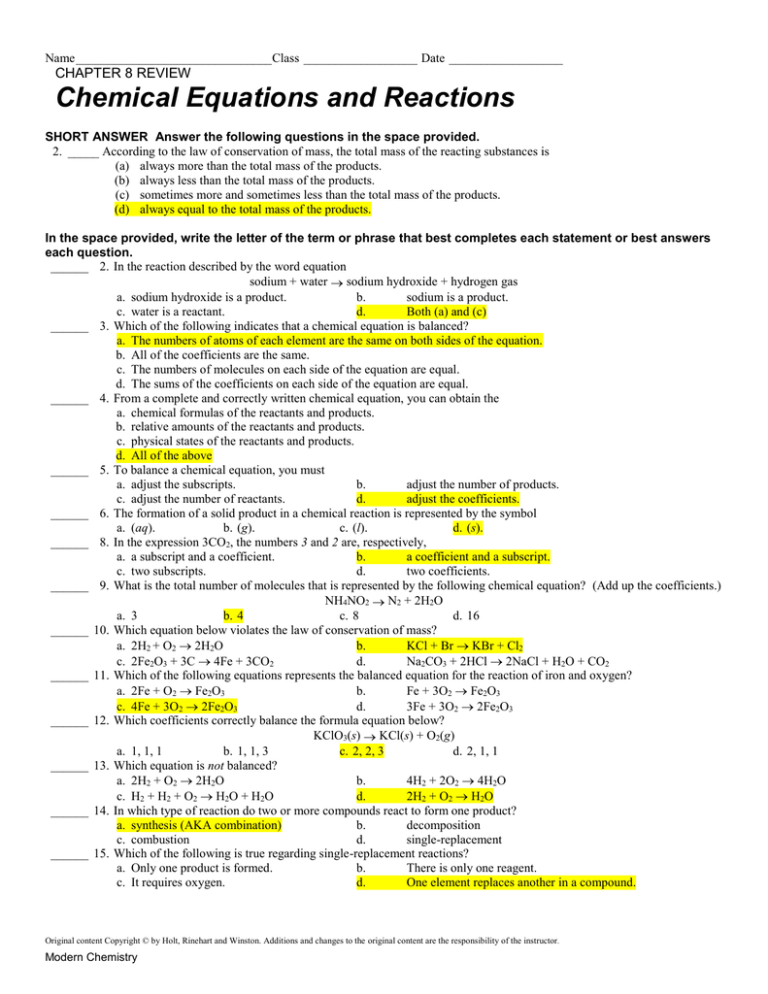
Name _______________________________Class __________________ Date __________________ CHAPTER 8 REVIEW Chemical Equations and Reactions SHORT ANSWER Answer the following questions in the space provided. 2. _____ According to the law of conservation of mass, the total mass of the reacting substances is (a) always more than the total mass of the products. (b) always less than the total mass of the products. (c) sometimes more and sometimes less than the total mass of the products. (d) always equal to the total mass of the products. In the space provided, write the letter of the term or phrase that best completes each statement or best answers each question. ______ 2. In the reaction described by the word equation sodium + water sodium hydroxide + hydrogen gas a. sodium hydroxide is a product. b. sodium is a product. c. water is a reactant. d. Both (a) and (c) ______ 3. Which of the following indicates that a chemical equation is balanced? a. The numbers of atoms of each element are the same on both sides of the equation. b. All of the coefficients are the same. c. The numbers of molecules on each side of the equation are equal. d. The sums of the coefficients on each side of the equation are equal. ______ 4. From a complete and correctly written chemical equation, you can obtain the a. chemical formulas of the reactants and products. b. relative amounts of the reactants and products. c. physical states of the reactants and products. d. All of the above ______ 5. To balance a chemical equation, you must a. adjust the subscripts. b. adjust the number of products. c. adjust the number of reactants. d. adjust the coefficients. ______ 6. The formation of a solid product in a chemical reaction is represented by the symbol a. (aq). b. (g). c. (l). d. (s). ______ 8. In the expression 3CO2, the numbers 3 and 2 are, respectively, a. a subscript and a coefficient. b. a coefficient and a subscript. c. two subscripts. d. two coefficients. ______ 9. What is the total number of molecules that is represented by the following chemical equation? (Add up the coefficients.) NH4NO2 N2 + 2H2O a. 3 b. 4 c. 8 d. 16 ______ 10. Which equation below violates the law of conservation of mass? a. 2H2 + O2 2H2O b. KCl + Br KBr + Cl2 c. 2Fe2O3 + 3C 4Fe + 3CO2 d. Na2CO3 + 2HCl 2NaCl + H2O + CO2 ______ 11. Which of the following equations represents the balanced equation for the reaction of iron and oxygen? a. 2Fe + O2 Fe2O3 b. Fe + 3O2 Fe2O3 c. 4Fe + 3O2 2Fe2O3 d. 3Fe + 3O2 2Fe2O3 ______ 12. Which coefficients correctly balance the formula equation below? KClO3(s) KCl(s) + O2(g) a. 1, 1, 1 b. 1, 1, 3 c. 2, 2, 3 d. 2, 1, 1 ______ 13. Which equation is not balanced? a. 2H2 + O2 2H2O b. 4H2 + 2O2 4H2O c. H2 + H2 + O2 H2O + H2O d. 2H2 + O2 H2O ______ 14. In which type of reaction do two or more compounds react to form one product? a. synthesis (AKA combination) b. decomposition c. combustion d. single-replacement ______ 15. Which of the following is true regarding single-replacement reactions? a. Only one product is formed. b. There is only one reagent. c. It requires oxygen. d. One element replaces another in a compound. Original content Copyright © by Holt, Rinehart and Winston. Additions and changes to the original content are the responsibility of the instructor. Modern Chemistry Name _______________________________Class __________________ Date __________________ ______ 16. Which of the following is true regarding double-replacement reactions? a. Two products are formed. b. The ions of the two reactants must be exchanged. c. A precipitate may form. d. All of the above ______ 17. A mixture of propane and oxygen react to form carbon dioxide and water. What type of chemical reaction is this? a. synthesis b. decomposition c. double-replacement d. combustion ______ 18. What type of chemical reaction does the following chemical equation represent? 2HCl(aq) + Cr(s) H2(g) + CrCl2(aq) a. composition b. single-replacement c. decomposition d. double-replacement ______ 19. Calcium carbonate, CaCO3, reacts to form calcium oxide, CaO, and carbon dioxide, CO 2. What type of reaction is this? a. synthesis b. replacement c. combustion d. decomposition ______ 20. What type of chemical reaction is represented by the following word equation? iron + oxygen iron(II) oxide a. synthesis b. replacement c. combustion d. double-replacement In the space provided, write the letter of the term or phrase that best completes each statement or best answers each question. ______ 1. The slightly soluble solid compound produced in a double-replacement reaction is called a a. gas. b. precipitate. c. combustion reaction. d. halogen. ______ 2. To balance a chemical equation, it is permissible to adjust the a. coefficients. b. subscripts. c. formulas of the products. d. number of products. ______ 3. In a chemical equation, the symbol (aq) indicates that the substance is a. water. b. dissolved in water. c. an acid. d. insoluble. ______ 5. The coefficients in a chemical equation a. indicate the number of moles of each substance that react. b. show the number of grams of each substance that react. c. are the molar masses of the substances. d. show the valence electrons for each atom. ______ 7. In a reaction, the ions of two compounds exchange places in aqueous solution to form two new compounds. This reaction is called a a. synthesis reaction. b. decomposition reaction. c. single-replacement reaction. d. double-replacement reaction. Write the correct term (or terms) in the space provided. 9. A small whole number that appears in front of a formula in a chemical equation is called a(n) __coefficient___________________________. 10. In a chemical equation, the symbol (l) indicates that the substance is ___liquid__________________________. 17. A substance combines with oxygen, releasing a large amount of energy as heat and light, in a(n) ___combustion__________________________. 20. A(n) ___formula equation__________________________ uses symbols and formulas to represent the names and relative amounts of reactants and products in a chemical reaction. 21. The law of ___conservation of mass__________________________ must be satisfied for a chemical equation to be balanced. 22. A(n) ____gaseous_________________________ product is sometimes indicated by an arrow pointing upward. Write a word equation for the chemical reaction in the space provided. 26. 2 ZnS(s) + 3 O2(g) 2 ZnS(s) + 2 SO2(g) Solid zinc sulfide reacts with gaseous oxygen to form solid zinc sulfide and gaseous sulfur dioxide Write a formula equation for each word equation in the space provided. 28. magnesium + oxygen magnesium oxide Mg + O2 MgO (only translated, not balanced) _______________________________________ 29. calcium carbonate calcium oxide + carbon dioxide CaCO3 CaO + CO2 (only translated, not balanced) ___________________________________ Original content Copyright © by Holt, Rinehart and Winston. Additions and changes to the original content are the responsibility of the instructor. Modern Chemistry Name _______________________________Class __________________ Date __________________ On the line to the left, identify each chemical equation as a synthesis, decomposition, single-replacement, or doublereplacement reaction. decomposition ______________ 30. 2 H2O(l) 2 H2(g) + O2(g) single replacement __________ 31. Cl2(g) + 2 KBr(aq) 2 KCl(aq) + Br2(l) synthesis (AKA combination) __ 32. CaO(s) + H2O(l) Ca(OH)2(s) double-replacement __________ 33. HCl(aq) + NaOH(aq) NaCl(aq) + H2O(l) Balance the following formula equations in the space provided. 34. AgNO3 + CuCl2 AgCl + Cu(NO3)2 2 AgNO3 + CuCl2 2 AgCl + Cu(NO3)2 _____________________________________________ 35. PbO2 PbO + O2 2 PbO2 2 PbO + O2 ____________________________________________________________ 36. Zn(OH)2 + CH3COOH Zn(CH3COO)2 + H2O Zn(OH)2 + 2 CH3COOH Zn(CH3COO)2 + 2 H2O ____________________________________ CHAPTER 16 REVIEW Reaction Energy In the space provided, write the letter of the term or phrase that best completes each statement or best answers each question. ______ 2. If gas A has a higher temperature than gas B, then the particles in gas A a. have greater average kinetic energy than those in gas B. b. have less average kinetic energy that those in gas B. c. contain the same average kinetic energy as those in gas B. d. may contain more, less, or the same average kinetic energy as those in gas B. ______ 4. The amount of energy absorbed by a system as heat during a process at constant pressure is the change in a. enthalpy. b. entropy. c. temperature. d. Gibbs free energy. ______ 10. A chemical reaction is exothermic when H is a. positive. b. negative. c. zero. d. constant. ______ 18. For an exothermic reaction, a. G is always positive. b. H is always negative. c. S is always positive. d. All of the above ______ 24. The melting of ice is always a(n) a. exothermic reaction. b. endothermic reaction. c. negative entropic reaction. d. catalyzed reaction. In the space provided, write the letter of the term or phrase that best completes each statement or best answers each question. ______ 1. As compared with separate gases, a mixture of gases is a. more random. b. less random. c. equally random. d. less favorable. ______ 6. An endothermic reaction has a. a positive enthalpy change. b. a negative enthalpy change. c. no enthalpy change. d. either a positive or a negative enthalpy change. ______ 7. Which of the equations below is an example of a thermochemical equation? a. Mg(s) + 2H3O+ (aq) + Cl (aq) Mg2 + (aq) + 2Cl (aq) +H2(g) + H2O(l) b. Mg + 2H3O+ + Cl Mg2 + + 2Cl + H2 + H2O c. 2H2(g) + 2O2(g) H2O(g) d. 2H2(g) + 2O2(g) H2O(g) + 483.6 kJ (thermochemical because it includes the heat information) Original content Copyright © by Holt, Rinehart and Winston. Additions and changes to the original content are the responsibility of the instructor. Modern Chemistry Name _______________________________Class __________________ Date __________________ Write the correct term (or terms) in the space provided. 12. The measure of the average kinetic energy of the particles in a sample of matter is its __temperature______________________. 13. The energy transferred between samples of matter because of a difference in their temperatures is called ____heat_________________________. 15. The enthalpy change is always the difference between the enthalpies of the ____products_______________________ and the ____reactants_______________________. 18. The ___H__________________________ is negative for exothermic reactions and positive for endothermic reactions. Write the answers to the following questions in the space provided. 25. How do the enthalpy of products and reactants differ in endothermic and exothermic reactions? Endo: reactants’ enthapies > products ________________________________________________ Exo: reactants’ enthapies < products _________________________________________________ ______________________________________________________________________________ ______________________________________________________________________________ 26. How does temperature differ from heat? Heat is the flow of energy, temperature is measure of average kinetic energy _________________ ______________________________________________________________________________ ______________________________________________________________________________ ______________________________________________________________________________ CHAPTER 17 REVIEW Reaction Kinetics Answer the following questions in the space provided. 1. The reaction for the decomposition of hydrogen peroxide is 2 H2O2(aq) 2 H2O(l) + O2(g). List three ways to speed up the rate of decomposition. For each one, briefly explain why it is effective, based on collision theory. Heat – molecules move faster/have more average KE and will decompose quicker _____________ Decrease pressure – favors products due to gas being produced and changing pressure __________ Catalyst – catalysts speed reaction without being consumed _______________________________ ______________________________________________________________________________ ______________________________________________________________________________ ______________________________________________________________________________ ______________________________________________________________________________ Write the answer on the line to the left. Show all your work in the space provided. 4. Answer the following questions using the energy diagram below. endothermic _____________ Is the forward reaction represented by the curve exothermic or endothermic? A catalyst is added to the reaction, which lowers the activation energy. Speed up ________________ Does the forward reaction rate speed up or slow down? Slow down ______________ Does the reverse reaction rate speed up or slow down? Original content Copyright © by Holt, Rinehart and Winston. Additions and changes to the original content are the responsibility of the instructor. Modern Chemistry Name _______________________________Class __________________ Date __________________ In the space provided, write the letter of the term or phrase that best completes each statement or best answers each question. ______ 3. One factor that cannot be adjusted in order to improve a reaction rate is a. temperature. b. surface area. c. nature of the reactant. d. concentration. ______ 4. A catalyst that increases metabolic processes is known as a(n) a. activated complex. b. rate-determining step. c. mechanism. d. enzyme. ______ 6. Catalysts affect reaction rates by a. forming an activated complex with lower energy. b. broadening the energy barrier. c. increasing the activation energy. d. changing the net thermodynamics of the reaction. ______ 9. What impact does an increase in temperature generally have on the rate of a reaction? a. It increases it. b. It has no impact. c. There is no way to measure the change. d. It decreases it. ______ 14. Two molecules cannot react if there is not enough a. kinetic energy. b. pressure. c. time. d. volume. ______ 17. A substance that increases the reaction rate but is not itself permanently consumed is a(n) a. intermediate. b. rate-determining substance. c. catalyst. d. activated complex. ______ 22. The value of H for an endothermic reaction is always a. positive. b. negative. c. zero. d. unknown. ______ 24. Which factor(s) can influence the rate of a reaction? a. surface area b. temperature c. concentration d. All of the above Write the answers to the following questions in the space provided. 26. List the five factors that can influence reaction rate. Temperature, pressure, concentration, surface area, catalyst _______________________________ ______________________________________________________________________________ ______________________________________________________________________________ ______________________________________________________________________________ CHAPTER 18 REVIEW Chemical Equilibrium In the space provided, write the letter of the term or phrase that best completes each statement or best answers each question. ______ 16. A chemical reaction that is at equilibrium always has a. a high Keq value. b. a forward reaction rate that equals the reverse reaction rate. c. equal concentrations of reactants and products. d. Both (a) and (b) Write the correct term in the space provided. 15.At equilibrium, the rate of the forward reaction is __equal__________________________ the rate of the reverse reaction. Write the answers to the following questions in the space provided. 23. Name three ways that chemical equilibrium can be disturbed. Temperature, pressure, concentration ________________________________________________ ______________________________________________________________________________ ______________________________________________________________________________ Original content Copyright © by Holt, Rinehart and Winston. Additions and changes to the original content are the responsibility of the instructor. Modern Chemistry
